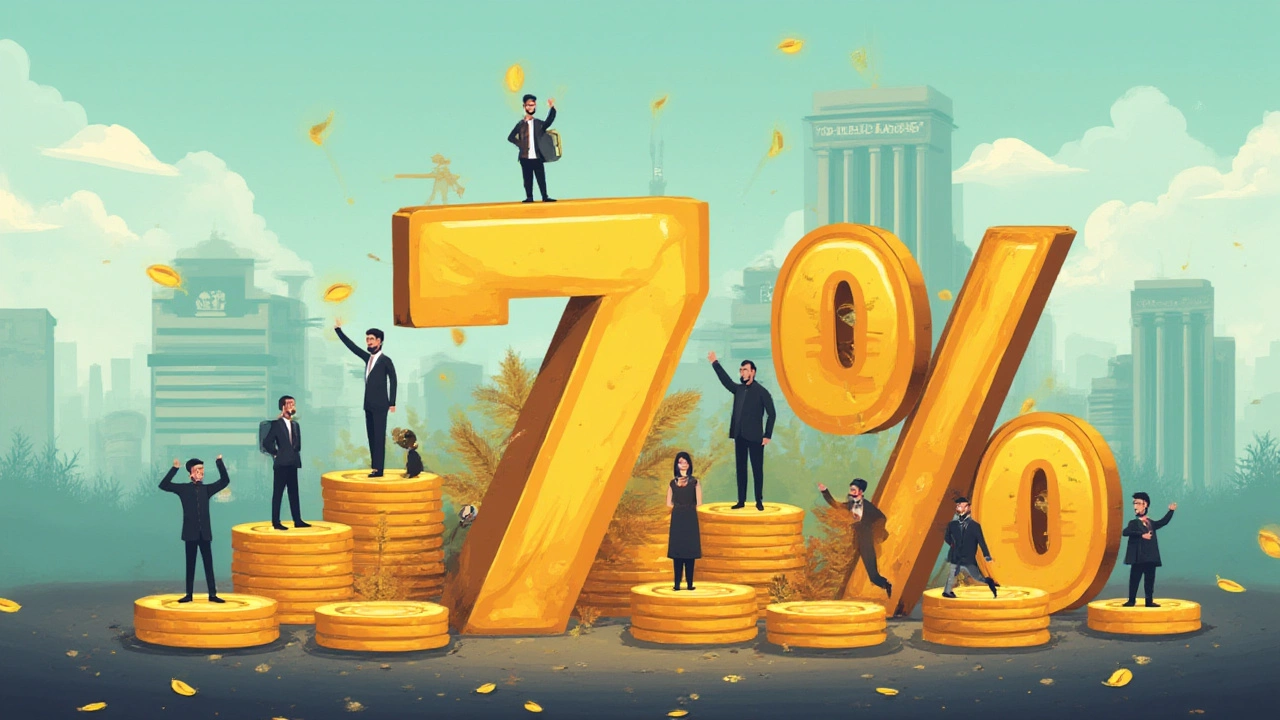If you blink, you might miss it: banks actually offering 7% interest rates on deposits. Sounds unreal, right? In the age where most banks act like 4% is some sort of big gift, hearing about a 7% interest rate on a savings account or fixed deposit can feel like stumbling on a secret level in a video game. So who’s behind these offers? Are they legit? And will you actually see that money in your account—or is there a catch bigger than my dog Buddy's appetite for leftover pizza crust?
Why 7% Interest Rates Stand Out in Today's Market
Let’s be real: if you talk to your parents, stories of double-digit bank interest feel like tales of dinosaurs and payphones. Since the Reserve Bank of India (RBI) and other central banks worldwide have trimmed rates over the years, a plain savings account now usually fetches you under 4%. So, any bank daring enough to dangle bank 7 percent interest in front of savers knows one thing—they’ll grab a lot of attention.
Why are they doing it? Some banks—especially newer ones or smaller private sector banks—use high rates as a marketing move. They want to attract new customers and big deposits fast. For you, the average saver, it’s a golden opportunity—if you know what you’re signing up for. Still, before you do a cartwheel for joy, you need to ask yourself: is it a regular savings account, a fixed deposit (FD), or a special scheme that locks in your money for years?
| Bank Name | Account Type | Highest Interest Rate (July 2025) | Tenure/Conditions |
|---|---|---|---|
| Bandhan Bank | Fixed Deposit | 7.25% | Special FDs, 600 days |
| Yes Bank | Savings Account | 7.00% | Balances above ₹5 lakh |
| IDFC First Bank | Savings Account | 7.00% | Balances above ₹10 lakh |
| RBL Bank | Fixed Deposit | 7.10% | Non-Senior, 456-459 days |
| IndusInd Bank | Fixed Deposit | 7.00% | 700 days |
Those numbers are real, as of July 2025. Some of these banks let even regular account holders in on the party—but many tie the highest rates to a big deposit or a specific FD. Use this data wisely: if you’re planning to just park your pocket change in a regular account and rake in 7%, chances are you’ll get a lower rate unless you meet their minimum balance or lock-in time.
Which Banks Offer 7% Interest—and What’s the Catch?
If you’ve started searching online for "which bank gives 7 interest,” you’ve probably found a list of familiar faces and a few less-famous names. The truth? Big, traditional banks like SBI, HDFC, and ICICI rarely offer 7% for plain-vanilla savings. Their fixed deposit rates for regular folk hover around 6-6.5% even for 5-year FDs, unless you’re a senior citizen (they usually get a slight boost, around 0.25%-0.5% extra).
More often, it’s banks like Bandhan, RBL, Yes Bank, and IDFC First trying to shake up the market. Bandhan Bank, for example, has run 7.25% FD offers, but you have to opt for special tenures like 600 days. Yes Bank and IDFC First Bank have thrown open 7% savings rates but only for higher balance slabs—meaning unless you keep ₹5 lakh or more, you might not pocket the headline rate. Don’t be surprised if you see asterisks everywhere; these rates usually apply on a portion of your balance, not the whole thing.
Also, keep your eyes peeled for promotional rates. Sometimes, banks pitch these for a "limited period" to get you through the door, but after a few months, rates quietly adjust down to reality. And there’s always the small print: early FD withdrawals usually mean lower interest, premature closure fees, and changing rates after maturity. If you’re someone who likes to move money around or needs liquidity, double-check those terms.
Another twist: not all savings accounts are the same. Some banks require you to open a ‘super-premium’ variant, often with requirements for a debit card, insurance, or bundled services. Check for additional charges; nobody wants their supposed windfall eaten up by maintenance fees. And always verify if the promised 7% is calculated daily and paid monthly, quarterly, or annually—it makes a bigger difference than you think.

Comparing 7% Offers: Savings Accounts vs Fixed Deposits
Let’s pit them head-to-head. A 7% rate on a fixed deposit (FD) and a 7% rate on a savings account look the same at first. But the fine print and the math can add up to different outcomes. With FDs, you’re locking your money for a fixed term—anything from a few months to a few years. Break the FD early, and you usually lose part of the interest. With a high-interest savings account, you're more flexible, but banks often use balance slabs, so only part of your money might earn the best rate.
Consider a working example. Say you put ₹5 lakh in a Yes Bank savings account. If you keep most of your balance above €5 lakh, you’ll get the 7%—anything under that earns less, which most people overlook. But with Bandhan Bank’s 7.25% FD, your ₹5 lakh is locked up for 600 days; if you need funds midway, you’ll pay a penalty.
Savings accounts with high rates almost always require higher balances. Unlike FDs, the rate can change at any time— banks set savings account rates as "floating"—meaning they can shift down (or up, if you’re lucky) depending on how the RBI changes its repo rate and how competitive the market is. It’s a balancing act: more liquidity and access in a savings account, but more predictability in an FD.
Now, taxes. Interest earned above ₹10,000 in a year in a savings account is taxable, and in FDs, the bank cuts TDS (tax deducted at source) if the interest crosses ₹40,000 for regular customers. Senior citizens get a little more leeway at ₹50,000. So, always calculate your net returns, not just the headline number, especially if you're in a higher tax bracket. It’s not unusual to see your actual take-home drop to under 5% after taxes if you’re not careful.
Risks, Tips, and Safety Checks Before Chasing 7%
Chasing that 7% rate, you need to ask a few tough questions. First, how safe is your deposit? In India and many other countries, your savings and FDs in banks are insured by government agencies (like DICGC in India) up to ₹5 lakh. Anything above that is at risk if the bank collapses, though collapses are thankfully rare. Still, small and new-age banks offering high rates should make you pause and check their credit ratings and recent financial statements. Look them up: how do they make their money, and what’s their NPA (non-performing assets) situation?
- Don’t park huge sums in just one high-rate bank. Spread deposits across banks for extra safety.
- Stay updated weekly, as small banks often revise rates quickly based on competition and the RBI’s monetary stance.
- Look at customer service complaints—you want easy access and quick grievance handling, especially if you’re handing over large sums.
- Read reviews on digital access and mobile banking; some high-rate banks skimp on tech, making daily transactions annoying.
People sometimes get too dazzled by double digits and ignore liquidity. Is there a lock-in? How soon can you get your cash out without losing interest? You don’t want to get trapped if you need the funds fast for, say, an emergency or sudden chance to adopt an adorable new puppy (looking at you, Buddy!).

Smart Tips to Get the Best 7% Interest Rate—And Actually Keep It
Ready to go for that 7%? Here are some tricks to make the most of those juicy rates—and avoid the usual traps. First, always check the bank’s credibility and health via recent RBI updates and third-party credit ratings—this isn’t just a suggestion for cautious uncles, it’s a must for everyone. Divide your savings among top-rated banks if you have more than the guaranteed limit; don’t let the 7% siren song push you into putting all eggs in one basket.
When picking between savings and FDs, weigh flexibility versus returns. Do you need regular access to your funds? Go for the high-yield savings, but keep an eye on balance requirements and fees (hidden or otherwise). Happy locking in your cash and want the rate fixed? Special FDs—and sometimes recurring deposits—are your friends. Remember, "promotional" rates can sneak down after a few months; set reminders to review your account and switch if needed.
Lastly, look at the fine print around rate slabs, minimum tenure, and compounding frequency. Some banks compound monthly; others quarterly or annually. Compound interest works like magic when it’s frequent. Don’t count on the rate being fixed unless it’s an FD. Track how your interest is calculated and paid—it can mean more in your pocket if you play the compounding game right.
And hey, with the right strategy, you can outsmart low rates and actually make your savings work for you—without staring at dull bank websites all day. Whether you’re planning for a rainy day or just giving yourself an excuse to buy extra treats for the dog, knowing who’s paying top dollar for your cash gives you more power over your money. Watch the market, read the small print, and don’t be afraid to ask the annoying questions. Banks love silence; your savings don’t.
